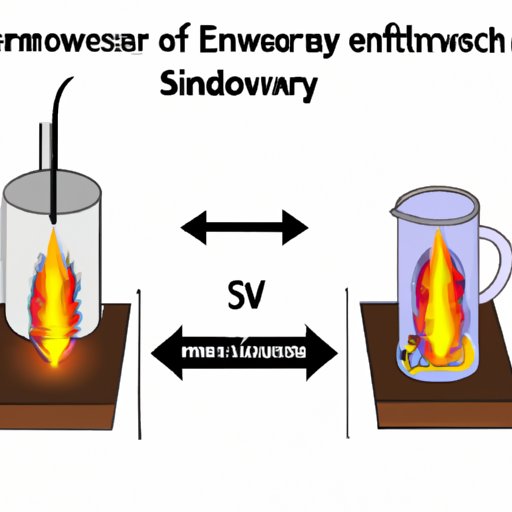Introduction
Have you ever heard of the Second Law of Thermodynamics? It is an essential concept in physics, chemistry, and engineering, and has significant implications for our understanding of the physical universe. In this article, we will explore the Second Law of Thermodynamics, its practical applications, and theoretical implications. By the end of this article, you will have a better understanding of energy flow in the universe.
What is the Second Law of Thermodynamics?
The Second Law of Thermodynamics is a fundamental principle of physics that relates to energy flow in the universe. It states that in any energy exchange or transformation, the total entropy of a closed system will increase over time, or at best, remain constant. Energy in a closed system will tend to move from hotter to colder areas, and in the process, become less usable.
Entropy is a measure of the randomness or disorder of a system. The Second Law states that the total entropy of a closed system can never decrease, only increase. In essence, the Second Law of Thermodynamics dictates the direction and natural progress of all physical phenomena in the universe.
Practical Applications of the Second Law of Thermodynamics
The Second Law of Thermodynamics is useful in understanding the efficiency of machines and natural systems. In fact, the law helps us understand why machines are never 100% efficient and why some energy is always lost as unusable waste heat.
One example is the internal combustion engine that powers many cars and trucks. This engine works by burning fuel to generate heat and pressure, which is then converted to rotational motion that powers the vehicle. However, not all of the heat produced by the burning fuel is converted into useable energy, and some of it is lost as waste heat through the exhaust system.
The Second Law also explains the transfer of energy in natural systems. For example, energy from the sun is transferred to plants, animals, and finally, to the soil in an ecosystem. However, as energy is transferred from organism to organism, it becomes less and less usable. This explains why ecosystems have limits to how much life they can sustain and why the energy within these systems tends to cycle or be recycled.
Comparing and Contrasting the First and Second Laws of Thermodynamics
While the Second Law of Thermodynamics deals with energy flow, the First Law of Thermodynamics deals with energy conservation. The First Law states that energy cannot be created or destroyed but can only be transformed or transferred from one form to another. Essentially, the first law tells us that energy is conserved in all physical systems.
The Second Law complements the First Law by explaining how useful energy becomes unusable over time. By understanding the two laws together, we can get a better understanding of how energy and matter behave in the universe.
Misconceptions about the Second Law of Thermodynamics
There are several misconceptions about the Second Law of Thermodynamics, one of which is that it violates the First Law. Some people believe that because the second law describes an increase in entropy and disorder, it somehow contradicts the conservation of energy. However, as we discussed earlier, the Second Law describes a loss of usable energy, not the destruction of energy.
Another common misconception is that the Second Law implies that things must always get worse over time. While it is true that energy becomes less sustainable over time within a closed system, the Second Law does not state that things must always get worse. Instead, it explains the natural tendency of energy to move from high to low concentrations, and for natural systems to cycle and recycle energy.
Theoretical Implications of the Second Law of Thermodynamics
The Second Law of Thermodynamics has also contributed significantly to our understanding of the physical universe and its origins. For example, the law predicts that at some point far in the future, all matter and energy in the universe will reach a state of maximum entropy. This has led some scientists to explore the idea of an eventual “heat death” of the universe.
Furthermore, the Second Law provides insight into the origins of the universe itself. Some scientists believe that the Big Bang, the event that created our cosmos, was a consequence of the Second Law, as matter and energy spread out from a high concentration to a low concentration.
Conclusion
The Second Law of Thermodynamics is an essential concept in physics, engineering, and many other fields, offering insight into the flow of energy and matter in the universe. It helps us understand why machines are never 100% efficient and why ecosystems have limits to how much life they can sustain. While misconceptions exist about the Second Law, knowing the facts can help us better understand why energy behaves the way it does in the physical universe. By continuing to learn about the Second Law, we can gain a deeper appreciation of the world around us.
